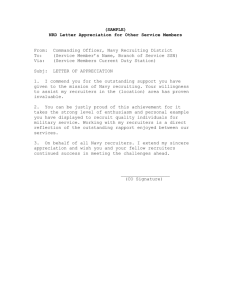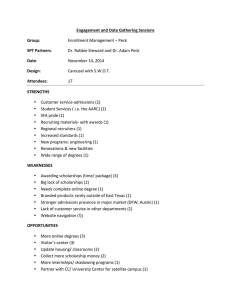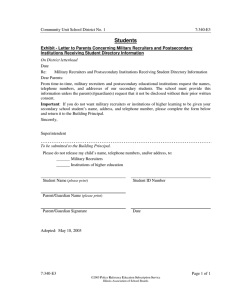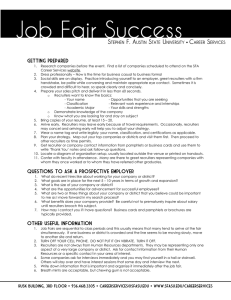6 The RAND Corporation is a nonprofit om
advertisement
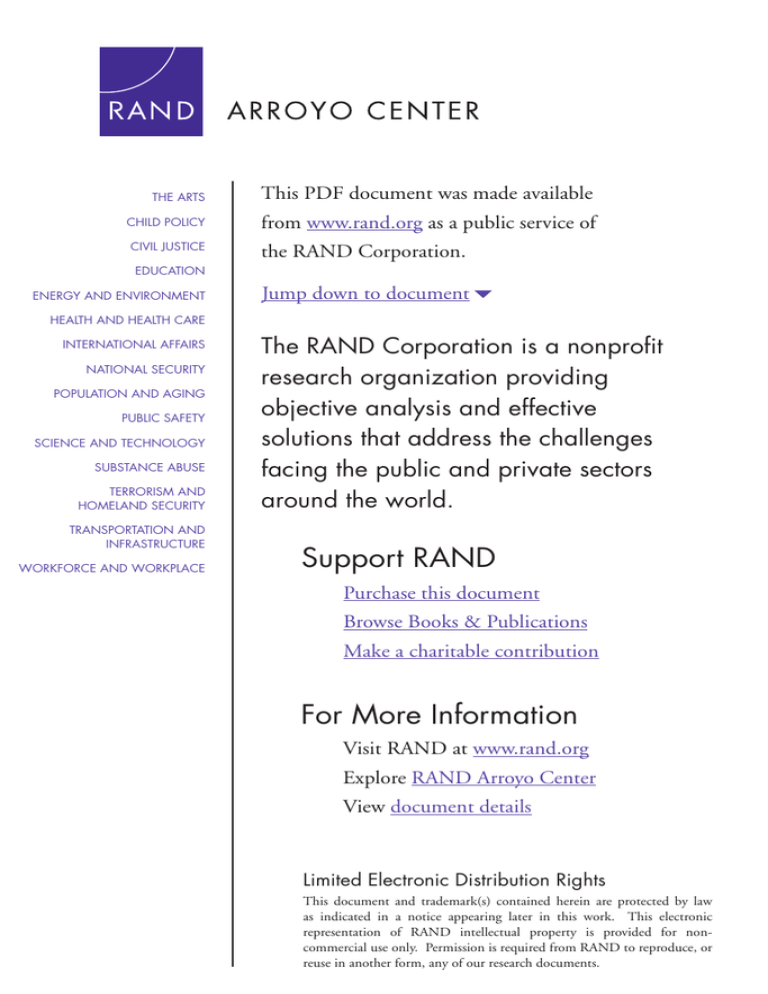
THE ARTS This PDF document was made available CHILD POLICY from www.rand.org as a public service of CIVIL JUSTICE the RAND Corporation. EDUCATION ENERGY AND ENVIRONMENT Jump down to document6 HEALTH AND HEALTH CARE INTERNATIONAL AFFAIRS NATIONAL SECURITY POPULATION AND AGING PUBLIC SAFETY SCIENCE AND TECHNOLOGY SUBSTANCE ABUSE TERRORISM AND HOMELAND SECURITY TRANSPORTATION AND INFRASTRUCTURE WORKFORCE AND WORKPLACE The RAND Corporation is a nonprofit research organization providing objective analysis and effective solutions that address the challenges facing the public and private sectors around the world. Support RAND Purchase this document Browse Books & Publications Make a charitable contribution For More Information Visit RAND at www.rand.org Explore RAND Arroyo Center View document details Limited Electronic Distribution Rights This document and trademark(s) contained herein are protected by law as indicated in a notice appearing later in this work. This electronic representation of RAND intellectual property is provided for noncommercial use only. Permission is required from RAND to reproduce, or reuse in another form, any of our research documents. This product is part of the RAND Corporation monograph series. RAND monographs present major research findings that address the challenges facing the public and private sectors. All RAND monographs undergo rigorous peer review to ensure high standards for research quality and objectivity. Human Resource Management and Army Recruiting Analyses of Policy Options James N. Dertouzos, Steven Garber Prepared for the United States Army Approved for public release; distribution unlimited The research in this report was sponsored by the United States Army under Contract No. DASW01-01-C-0003. Library of Congress Cataloging-in-Publication Data Dertouzos, James N., 1950– Human resource management and Army recruiting : analyses of policy options / James N. Dertouzos, Steven Garber. p. cm. “MG-433.” Includes bibliographical references. ISBN-13: 978-0-8330-4004-6 (pbk. : alk. paper) 1. United States. Army—Recruiting, enlistment, etc. 2. United States. Army— Personnel management. I. Garber, Steven, 1950– II. Title. UB323.D438 2006 355.2'23620973—dc22 2006027016 The RAND Corporation is a nonprofit research organization providing objective analysis and effective solutions that address the challenges facing the public and private sectors around the world. R AND’s publications do not necessarily reflect the opinions of its research clients and sponsors. R® is a registered trademark. © Copyright 2006 RAND Corporation All rights reserved. No part of this book may be reproduced in any form by any electronic or mechanical means (including photocopying, recording, or information storage and retrieval) without permission in writing from RAND. Published 2006 by the RAND Corporation 1776 Main Street, P.O. Box 2138, Santa Monica, CA 90407-2138 1200 South Hayes Street, Arlington, VA 22202-5050 4570 Fifth Avenue, Suite 600, Pittsburgh, PA 15213-2665 RAND URL: http://www.rand.org/ To order RAND documents or to obtain additional information, contact Distribution Services: Telephone: (310) 451-7002; Fax: (310) 451-6915; Email: order@rand.org Summary The U.S. Army Recruiting Command (USAREC) is charged with providing the Army with an ongoing flow of qualified volunteers adequate to meet future active-duty accession requirements. Success is highly dependent on several factors that USAREC can control and several others that it cannot control. Among the latter are manpower requirements (demand for accessions) as well as supply factors such as market demographics, alternative labor market and educational opportunities for youth, and attitudes about military service. Whatever the prevailing supply and demand conditions, however, policymakers have several policy levers for increasing the flow of enlistment contracts. Most manpower research has focused on the roles of recruiting resources such as military pay, enlistment benefits, advertising programs, and numbers of recruiters. Although such policy instruments have demonstrable expansion effects, they are quite costly to use. For example, Dertouzos and Garber (2003) provide marginal cost estimates of increasing high-quality enlistments via expansions in military pay, the recruiting force, and advertising ranging between $13,000 and $60,000 per additional high-quality recruit. In contrast, there is little available research on a range of human resource management policies that are capable of enhancing the productivity of the recruiting force. These policies include personnel selection and training, recruiter assignment, performance measurement, and the design of incentive systems that motivate recruiters to be more productive. More effective policies in these domains could increase enlistments for little, if any, additional cost. xv xvi Human Resource Management and Army Recruiting This report details research designed to develop new insights to help guide future recruiter-management policies. The research involves econometric analyses of three large and rich datasets. Methods In Chapter Two, we analyze determinants of the productivity of individual regular Army recruiters in enlisting both high- and lower-quality youth from 1998 to 2000. During this period, recruiters were missioned and rewarded on an individual basis. The data include monthly observations for more than 10,000 recruiters and a total of more than 130,000 observations on recruiter-month pairs. This analysis probes the characteristics of recruiters that are associated with higher and lower rates of productivity and how productivity relates to matches between recruiter characteristics and the characteristics of the markets (station areas) to which they are assigned. The analyses provide insights relevant to selection of soldiers for assignment to recruiting duty as well as the types of markets to which recruiters with specific characteristics might be best assigned. In Chapter Three, we analyze data for the 30-month period from January 2001 through June 2003. During this period, all stations were missioned at the station level and recruiting success was defined in terms of meeting missions as a team. Thus, the unit of analysis is a station-month, and the dataset includes information for roughly 1,600 stations and a total of more than 42,000 station-month pairs. This analysis focuses on factors determining the probability that a station will meet all of its regular Army missions, plus any losses from the Delayed Entry Program (DEP) charged during the month, in which case recruiters who wrote at least one contract could be eligible for station-level bonus points. (Almost 60 percent of stations also have U.S. Army Reserve (USAR) missions; these stations must meet both their regular Army and USAR missions for recruiters to be eligible for station-level bonus points.) This analysis also probes the extent to which allocations of regular Army missions to stations achieves equity across Summary xvii recruiters in the sense of equalizing the probabilities of meeting these missions. Chapters Four and Five analyze the same data used in Chapter Three, applying models developed to focus on missioning policies to promote productivity (efficiency) in regular Army recruiting. In particular, we estimate models determining the number of high-quality enlistments by stations on a monthly basis and use the results to simulate or predict the effects of alternative missioning policies during the period covered by the data. The models separately identify the determinants of recruiter effort and the determinants of the quality of a station’s market area. The key ideas underlying the model are that (a) contract production depends on the quality of the station’s market area and the effort level of the recruiters, (b) effort is likely to increase as missions become more difficult, as long as they aren’t so difficult that they discourage recruiters and undermine motivation, and (c) in better markets, less effort is required for recruiters to sign high-quality youth. In Chapter Six, we study various relationships between recruiting and the career paths of soldiers. More specifically, we use a dataset on nearly 90,000 enlisted personnel who entered the Army during the ten-year period comprising fiscal years 1987 through 1996 to analyze several outcomes, including which soldiers became recruiters, how long recruiters stayed in recruiting, and how recruiting duty and productivity in recruiting affected promotion to the grades of E-6 and E-7 and the likelihood of remaining in the Army until 2003. Key Findings The analysis in Chapter Two relates numbers of high-quality and total enlistments to market characteristics, traditional supply factors, and attributes of recruiters. The findings for the period 1998 to 2000, when missions and award points were assigned on an individual basis, include the following. xviii Human Resource Management and Army Recruiting • On average, an increased mission of one high- or low-quality contract resulted in an increase of only 0.12 contracts. In contrast, estimates reported in Chapter Four imply three times as much responsiveness during 2001 to 2003, a period when missions were assigned to stations, missions per recruiter were lower, and the general recruiting environment may have been better. This suggests that teamwork was effective during the latter period, that responsiveness to mission is higher when the difficulty of making mission is lower, or both. • Our estimates enable us to rank groups of factors in terms of their importance in explaining variations in enlistment outcomes. Missions and market and demographic factors are most important in this regard. In decreasing order of importance, other important factors are nationwide differences in the recruiting environment over time, measured personal attributes of recruiters, station size, and region of the country. • Regarding relationships between specific recruiter attributes and productivity, some of which can be helpful in selecting soldiers for assignment to USAREC, there are several noteworthy patterns. First, younger male recruiters with dependents tend to be especially productive. Second, recruiters whose pre-recruiting military occupational specialties (MOSs) are in technical, combat, or intelligence areas tend to be more productive than those whose pre-recruiting MOS is in logistics. Third, recruiter Armed Forces Qualification Test (AFQT) scores and levels of education seem to have no effect on recruiting productivity. • We also find evidence that unmeasured personal attributes of recruiters account for more of the variation in production levels than do the attributes that we were able to measure. Potentially important unmeasured attributes are soldiers’ talent for selling, their general levels of motivation and energy, and their time-management skills. • We also find strong patterns regarding relationships between recruiter attributes and the characteristics of market areas of the stations to which they are assigned. Broadly stated, recruiters are more productive when their characteristics are similar to those of Summary xix many of the youth in their market areas. For example, recruiters assigned to stations in their home states are more productive. Moreover, African American recruiters are more productive than other recruiters in areas where African Americans comprise large proportions of the local population. Female recruiters are more effective in signing women, although they appear to be less effective in signing men. • Recruiters in stations with more than one regular Army recruiter tend to be less productive than those in one-recruiter stations, and these differences are substantial. For example, stations with six or more “on-production, regular Army” (OPRA) recruiters are on average 14 and 17 percent less productive than one-recruiter stations in enlisting high-quality candidates and all candidates, respectively. Productivity differences associated with station sizes might reflect unmeasured factors such as attributes of soldiers assigned to one-recruiter stations and greater familiarity between recruiters and members of smaller communities, including high school counselors, coaches, and other youth influencers. These differences may also reflect differences in unmeasured aspects of attitudes toward the military between larger and smaller communities. The analysis in Chapter Three uses data from 2001 to 2003, a period when missions were assigned on a station-level basis and award points were available for success as a team, including both regular Army and USAR recruiters, if any. The focus is on how station-level factors affected the probability that a station met all three of its regular Army production goals (i.e., grad alphas, senior alphas, and others1) taking account of substitution rules and DEP losses. Key findings include the following. • Our estimates regarding the roles of traditional supply factors are broadly consistent with earlier results. 1 “Alpha” denotes a high-aptitude recruit—an enlistee who scored in categories I through IIIA on the AFQT. “Grad” and “senior” refer to high school graduates and high school seniors, respectively. xx Human Resource Management and Army Recruiting • Stations met their regular Army goals during one-third of the station-months in our sample. If their missions for grad alphas had been one contract higher, the probability of meeting these missions would have fallen to about 17 percent; the analogous figure for adding a senior alpha mission is 20 percent. Thus, the data indicate that recruiters have a more difficult time locating and signing additional grad alphas than senior alphas. • Adding one contract to the mission for “others” (than grad or senior alphas) lowers the probability of success from the baseline 33 percent to 28 percent. Comparing this result to those just reported for additional high-quality missions suggests that highquality contracts are about three times as difficult to obtain as lower-quality ones. Since the ratio of award points for high-quality contracts to lower-quality contracts is only two to one, this suggests that recruiters are not being given adequate incentives to sign high-quality youth, considering the relative costs of producing the two types of contracts. Equity in missioning is important in and of itself and because if recruiters perceive unfairness, it could undermine morale and effort and thereby reduce productivity. Accordingly, much of the analysis reported in Chapter Three focuses on the extent to which missions give stations equal chances of success in meeting their regular Army goals. Our analysis provides insights about types of factors and specific factors within each type that are associated with differences across stations in the probability of succeeding in this sense. Our key findings related to equity of missioning include the following. • Stations with USAR missions meet their regular Army goals almost as often as stations without USAR missions (34.6 percent versus 37.2 percent). But stations with USAR missions succeed according to the Army’s definition of team success—i.e., meeting all regular Army and USAR missions—much less frequently than do stations without USAR missions, which in their cases requires meeting only regular Army missions. In particular, stations with USAR missions succeed only 16.7 percent of the time Summary xxi as compared with 37.2 percent for stations that don’t have USAR missions. • The most important set of factors accounting for differences in the probability of success relative to regular Army goals is the demographics of the stations’ market areas. The following three sets of factors are each roughly 75 percent as important as demographics: (a) factors that differ over time but are largely the same nationwide within months, such as youth attitudes, (b) numbers of USAR recruiters and the levels of USAR missions, and (c) supply or market variables (qualified military available (QMA)2 per OPRA, the level and change in the local unemployment rate, and the level of civilian wages in the local area). • The analysis also details characteristics of markets associated with higher and lower probabilities of success in meeting regular Army missions. These findings provide guidance about how missions could be adjusted to promote equity across stations. To promote equity, missions should be decreased in relative terms for stations with: (a) relatively high proportions of veterans aged 43 to 54 and 65 to 72 in the state population; (b) large proportions of Hispanics, African Americans, and children living in poverty in the local population; and (c) relatively high USAR missions per OPRA recruiter, holding the number of USAR recruiters constant. Moreover, to equalize probabilities of success over seasons, missions should be lowered in March and May. • To promote equity, missions should be increased in relative terms for stations (a) with relatively high proportions of veterans aged 33 to 42 and 56 to 65 in the state population, (b) with more USAR recruiters per OPRA recruiter, holding the USAR missions per OPRA constant, (c) in the South and, to a lesser extent, in the North Central region, and (d) with higher unemployment rates. Moreover, to equalize probabilities of success over seasons, missions should be increased in December. 2 QMA counts net out from youth population totals the estimated numbers of youth in college and those who are ineligible for military service for physical reasons or because of criminal records. xxii Human Resource Management and Army Recruiting We also analyzed the extent to which succeeding relative to regular Army missions reflects random factors that recruiters cannot control, an issue that is crucial for assessing station performance. For example, one might be inclined to observe the number of consecutive months a station fails to meet its regular Army mission and intervene after a particular number of months. Our analysis reveals potential pitfalls in such a procedure. More specifically, we compare the proportion of stations that would be expected to fail due to chance, given their stations’ missions and the quality of their markets, for a specific number of consecutive months with the proportions that actually failed. For example, among stations that have failed six months in a row, half would be expected to fail because of pure chance. The analogous proportions for stations failing 3 and 12 months in a row are 82 and 23 percent. The analyses reported in Chapters Four and Five develop and implement new models and methods designed to decompose production of high-quality contracts into its two major underlying determinants, namely, the quality of the station’s market area and the effort levels expended by the station’s recruiters to sign high-quality youth. We use the results to simulate the effects of various missioning policies. The key findings are as follows. • As expected, recruiter effort levels increase at a decreasing rate as the difficulty of meeting the regular Army high-quality goal increases from low levels of difficulty. The evidence is overwhelming, however, that during the sample period, missions were virtually never difficult enough to discourage recruiters to the extent that effort was reduced. • A station’s recent high-quality production relative to high-quality mission is an important determinant of effort levels and the responsiveness of effort to increases in missions. More specifically, stations with higher ratios of high-quality enlistments to highquality missions over a 12-month period ending three months before the current month expended considerably more effort, and their effort levels were considerably more responsive to increases in missions. We believe that these findings are attributable to Summary • • • • • xxiii higher morale, confidence, or both among recruiters in stations that have recently been more successful. These results suggest that during January 2001 through June 2003 there were unexploited opportunities to increase high-quality enlistments in two general ways: (a) reallocating the aggregate high-quality missions differently over stations and over months, and (b) increasing aggregate high-quality missions. Regarding reallocating the actual national-level mission over stations and months, policy simulations suggest that the potential improvements were significant but not dramatic. In particular, a reallocation of only 2 percent of total missions could have increased total high-quality enlistments by 1.0 percent. An optimal reallocation (involving about a third of all missions) could have resulted in a 2.7 percent productivity increase. Regarding increases in the aggregate high-quality mission, our simulations suggest quite substantial potential gains. For example, during the time period studied, increasing the monthly highquality mission by one contract for the half of stations that would be most responsive—which involves a 15.5 percent increase in aggregate high-quality missions—is predicted to have had the potential to increase high-quality enlistments by 7.4 percent. Whether such gains would be possible in the current recruiting environment is unknown. Our microeconomic theory underlying the econometric models implies that there is a conflict between equity—in the form of equalizing the difficulty of making mission—and efficiency—in the form of maximizing expected contracts—if and only if effort functions differ across stations. The strong evidence that effort functions do differ (according to the degree of recent success) indicates that there is such a conflict. Market quality varies considerably, and in intuitively sensible ways, with variations in dozens of variables representing local economic conditions, market demographics, seasonal effects, the size and age distribution of the veteran population, and the region of the country. xxiv Human Resource Management and Army Recruiting • Due to differences across stations and over time in market quality and other factors, the additional effort required to sign another high-quality youth varies considerably over stations and months. For example, this effort level is considerably more than twice as high on average for the 20 percent of stations confronting the least favorable conditions than for the 20 percent of stations facing the most favorable conditions. In addition, most of the unexplained variation in productivity of effort across stations is attributable to (a) randomness that averages out within a year, and (b) unmeasured, and perhaps unmeasurable, factors that are specific to individual stations. • The major factors affecting market quality are as follows, in decreasing order of importance. It takes less effort to sign highquality youth: (a) in low civilian-wage areas; (b) where QMA per OPRA is high; (c) in markets with the following demographic characteristics—urban, relatively high proportions of non-Catholic Christians, and relatively low proportions of African Americans and children living in poverty; (d) in the months of June, July, September, and October, especially as compared with May; (e) in areas with relatively high proportions of veterans aged less than 43 and relatively low proportions of veterans aged 56 to 65; and (f) in regions other than the Mountain region. • We also simulated a policy that, in contrast to current policies, doesn’t add DEP losses to missions in assessing monthly success. This policy scenario also increases missions equally for all stations to hold total goals constant. The results suggest that about 0.2 percent of production would be lost from such a policy change. This is because DEP losses tend to be higher for stations that have been more productive recently (i.e., signed more contracts in the recent past, and therefore tend to have more enlistees in the DEP), and asking for more from relatively successful stations is effective because such stations are more responsive to increases in missions. • Missioning all recruiters at the same level for all stations and months would have gained 1 percent in terms of high-quality enlistments relative to the missions that were actually used. Summary xxv Most of these gains are due to smoothing missions over months, which cannot be done unless aggregate contract requirements are smoothed over months. Our analysis in Chapter Six of Army careers and recruiting examined several outcomes. The key findings are as follows. • The roughly 8 percent of soldiers who became recruiters were relatively high quality in terms of indicators such as AFQT scores, high school graduation, and speeds of promotion (before becoming recruiters) to E-4 and E-5. Such factors can increase or decrease the probability of becoming a recruiter by four percentage points, which is very substantial compared with the average of 8 percent. • Soldiers who had been recruiters were more likely to have been promoted to E-6 and E-7 by 2003, holding other factors constant. See Table S.1. • Recruiters who were relatively slow in being promoted to E-4 and E-5 were more likely to leave recruiting in less than one year, and those who were promoted relatively quickly to E-4 and E-5 were more likely to stay in recruiting for more than three years. • We also analyzed the effects of recruiting performance, measured in various ways, on the likelihood of promotion to E-6 and E-7 by 2003. When recruiting performance is defined in terms of tenure, we find that (a) recruiting for less than one year had no effect on subsequent career progression (i.e., there seems to be no penalty for starting recruiting and failing); (b) those who were in recruiting for less than two years, but more than one, had a substantially higher average probability of promotion to E-6 than Table S.1 Predicted Probabilities of Promotion by 2003, Recruiters Versus Nonrecruiters: 1991 Entering Cohort Recruiters Nonrecruiters Probability of Promotion to E-6 0.892 0.806 Probability of Promotion to E-7 0.123 0.099 xxvi Human Resource Management and Army Recruiting soldiers who had never recruited (0.88 versus 0.72 for nonrecruiters) and a slightly higher probability of promotion to E-7 (0.055 versus 0.046); (c) recruiting for two to three years relative to one to two years had no effect on promotion prospects; (d) those who recruited for three or more years were substantially more likely to make E-6 and E-7 than soldiers who never recruited, with a 0.94 chance of E-6 (versus 0.72 for nonrecruiters) and 0.176 chance of making E-7 (versus 0.046 for nonrecruiters). • We find little, if any, effect of contract production levels on promotion rates. However, we find substantial effects of high-quality production ratios (high-quality contracts divided by high-quality missions) at the station and recruiter levels that are above average relative to other stations and recruiters, respectively, during the same time period. For example, recruiters in stations with particularly low relative performance have a 78 percent chance of making E-6, compared with probabilities of 83 percent and 87 percent for recruiters from stations with average and particularly good relative performance, respectively. The corresponding probabilities for promotion to E-7 are 4, 6, and 9 percent. • We also found that recruiters were substantially more likely to remain in the Army until 2003 than nonrecruiters, with probabilities of 89 and 82 percent, respectively. Implications for Effective Recruiter Management Our research demonstrates that various types of human resource management policies can be very helpful in meeting the Army’s ambitious recruiting requirements. Although the gains from any individual policy change appear to be modest, implementing several policy changes in combination could save the Army hundreds of millions of dollars annually. Indeed, based on an incremental cost of $6,000 per recruit attracted by increasing recruiters, each one percent increase in high-quality enlistments generated by a more effective management approach could save the Army $3.6 million annually. Summary xxvii In Chapter Seven, we consider implications of our findings for human resource policies in the areas of selecting soldiers for recruiting duty, assigning recruiters to stations, missioning to promote equity across recruiters, missioning to increase recruiting production, using promotions to motivate and reward recruiters, and screening out recruiters who are underproducing. Our analyses have focused on potential means of improving recruiting outcomes. To consider potential policy changes, however, we adopt the perspective of the U.S. Army, rather than USAREC alone, because many policies that we have found to offer increases in recruiting production may impose costs on other commands. For example, assigning unusually good soldiers to recruiting involves a relatively high burden on the commands losing some of their most highly valued personnel. Recruiter Selection • Some recruiter attributes are very helpful in predicting recruiter productivity. Our findings suggest that efforts to identify and measure additional recruiter attributes that are expected to be strong predictors of recruiting success should continue to receive high priority and that data should be developed to enable future empirical verification that these attributes really do have substantial effects on productivity in the field. • Young recruiters are more productive. By adding about 500 young (under age 30) recruiters and reducing the number of older recruiters (over 35) by the same number, the Army could increase overall productivity by about 1 percent. To decide whether this is a sound policy change, the Army should consider the relative opportunity costs of reassigning younger and more senior personnel, and effects (that are likely to differ by MOS) on younger soldiers of interrupting their careers for temporary assignment to recruiting. xxviii Human Resource Management and Army Recruiting • Recruiters from traditional military occupations are more productive. In deciding whether to increase the proportions of recruiters coming from MOSs such as combat arms or intelligence to increase productivity, the Army should consider the relative opportunity costs of reassigning soldiers with different MOSs. • Empirical results suggest a possible disadvantage of private contracting. Contractors used for recruiting are likely to be older, retired military personnel whom young prospects are less likely to trust or relate to as role models. Of course, this cost may be balanced by other benefits. Recruiter Assignment • Recruiters who are similar to the population in their stations’ market areas are more successful. USAREC, brigades, battalions, and companies might consider innovative approaches to improving this matching. For example, it may be sensible to assign recruiters to especially appropriate stations a month or two before an opening is expected to occur or to delay assignment of some new recruiters for a month or two until an especially appropriate slot opens up. • Recruiters assigned to their home states are more productive. Another attractive option, given our results on young recruiters, is to expand programs that enable recent enlistees to help with recruiting at their home-area stations. Setting Missions to Achieve Equity • The awards incentive system may under-reward production of high-quality contracts. Recruiters accrue points on a monthly basis for contracts that they and their stations produce. Accrual of specified numbers of points Summary xxix over specified numbers of months lead to command-level awards such as stars, badges, and rings. Discrepancies between the relative costs of and the relative points for signing high- and lower-quality prospects, combined with the availability of station bonus points for recruiters signing any prospects, may induce recruiters to direct too much effort to enlisting lower-quality prospects. Increasing the relative points for high-quality contracts should be considered. • Significant inequities exist among markets. The substantial variation in the probabilities of success across stations could be lessened through more careful consideration of demographic factors. • From an equity perspective, the current treatment of stations with USAR recruiters is problematic. Improved coordination of USAR and regular Army missioning could increase both equity and the number of high-quality enlistees. Setting Missions to Increase Productivity • Efficient missioning requires reliance on past performance. The lion’s share of the potential gains to mission reallocations is due to greater responsiveness of effort to missions in stations that have been more successful recently. In allocating missions, USAREC should consider more heavy reliance on recent past performance, while being careful to avoid strong disincentives for productivity that could result if recruiters perceive that productivity is punished with higher future missions. • Production of high-quality enlistments might be increased by increasing total missions, but there are limits and pitfalls. In considering increases in aggregate high-quality missions, the following should be kept in mind: (a) the marginal impacts of increasing aggregate missions diminish as missions increase, (b) increased short-run productivity may come at a long-run cost because only a xxx Human Resource Management and Army Recruiting fraction of the extra contracts missioned would actually be attained, and most importantly, (c) the difficulty of recruiting has changed dramatically since 2003, and as a result, higher missions may be unachievable today; if so, raising them could prove counterproductive. • Mission allocations reflecting market quality and recruiter responses can increase high-quality enlistments and save money. Productivity improvements achieved by reallocating a fixed total mission could be almost costless. Moreover, if requirements were to increase, productivity improvements resulting from use of a mission allocation scheme based on our econometric model could save substantial resources. For example, every additional 1,000 high-quality recruits gained through better mission allocation could save the Army $6 million if the alternative were to increase enlistments by 1,000 through increases in the number of recruiters. • The measure of recent past success we employed in the data analysis has desirable attributes, but alternative measures should be considered. The measure we used in the data analysis has the advantages of (a) being implementable in real time, and (b) mitigating incentives to limit production to avoid future mission increases. However, the use of a missioning process that could be viewed as “punishing success,” as well as the task of communicating it to the field, raise leadership and morale issues that we haven’t analyzed. • The addition of DEP losses to missions to create performance goals did not undermine productivity during 2001 to 2003, but this policy should be reviewed. USAREC cannot accurately predict stations’ DEP losses that will occur during future months for which USAREC must determine missions. If missions are allocated optimally (i.e., to maximize expected contracts at the command level), then adding DEP losses to station goals (the current practice)—which deviates from the optimal Summary xxxi missions—will tend to decrease high-quality enlistments. USAREC should consider other approaches to limiting DEP losses that are not directly connected to the missioning, points accrual, and awards processes. For example, USAREC might consider a policy of providing special recognition for stations that have unusually low DEP-loss rates or innovative DEP-management programs. • A large portion of the short-term variation in enlistments is due to randomness. Much of the monthly variation in contracts is due to chance events that average out of the course of a few months. This suggests that missions might be specified as applying to longer time intervals than a single month (e.g., a quarter). Promotion Prospects and Incentives for Recruiting • On average, becoming a recruiter increases promotion rates. We have been told by many personnel at USAREC and by recruiters in the field that there is a widespread view among noncommissioned officers (NCOs) that being assigned to recruiting is a “career killer” because it worsens promotion prospects. The leading concern in this regard appears to be the detrimental effects on future promotion prospects of interrupting a soldier’s career in his or her primary MOS. Our data analyses indicate, however, that serving as a recruiter improved promotion prospects. Spreading the word could increase rates of volunteering for recruiting and help maintain the morale of recruiters. • Recruiters whose stations perform well relative to other stations are promoted faster. We cannot judge whether the magnitudes of the rewards for successful recruiting are at appropriate levels, but it is clear that there is a significant incentive in the form of improved promotion prospects for recruiters to be productive. xxxii Human Resource Management and Army Recruiting Identifying and Dealing with Unproductive Recruiters • The Army appears to be using a sound management policy of replacing, but not punishing, new recruiters who are consistently unproductive. Large proportions of recruiters who consistently underproduce during the first several months of their tours might not deserve negative personnel actions. It might make sense to replace them, nonetheless. It appears that the Army is applying sound management practices by returning unproductive new recruiters to their primary MOSs and not slowing their career progressions in those occupations.
